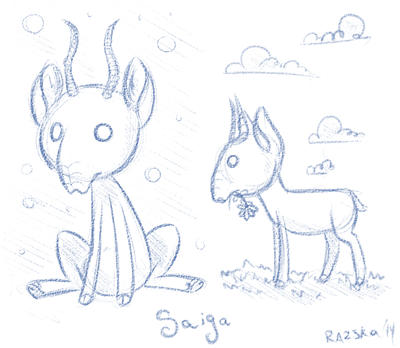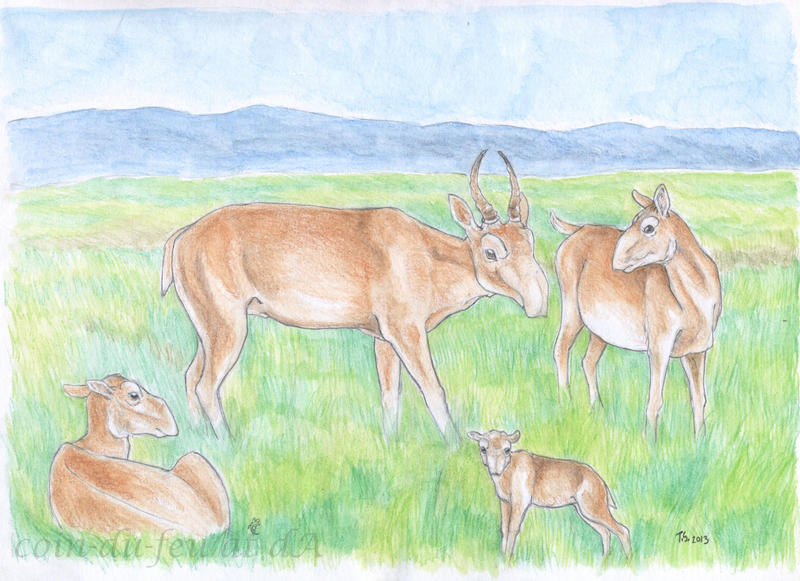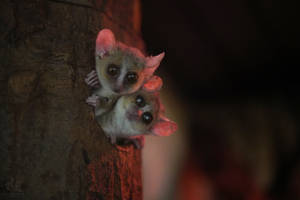While the Saiga was first described to science in 1766, it has moved around in family classification quite a few times, as scientists were not able to agree as to whom was their closest relation. In 2013, the Saiga was placed in the family from which the Springbok and Gerenuk each form separate branches, though for a time, it was notoriously thought to be a mix between an Antelope and Sheep.
Saigas are relatively small, standing between 60 and 80 centimeters tall at shoulder height (2 ft to 2 ft 7 inches) and weighing between 36 to 63 kg (79 to 139 lb). They have a short-haired, cinnamon-coloured coat in summer, though in winter the density increases up to 70 percent and turns white. The underbelly is light or white coloured throughout the year, and they have a small mane on the underside of the neck. Only the males of the species develop horns which grow vertically upwards.
Saigas are migratory animals, and will alternate their grazing habitat in line with the winter and summer seasons. They occur in the steppe and grasslands of Russia, Kazakhstan and Mongolia, where they will move north during the summer, and south for the winter. They can cover up to 72 miles of land in a single day, and can reach speeds of up to 50 miles an hour (80 km/hour).
When Saigas give birth to young in the spring, they will congegrate in large numbers, in which the females will birth within a week from one another. Up to two thirds of the births a year will consist of twins, a fairly high number. When moving towards the summer grasslands, Saiga herds will fall apart in smaller herds, which will congegrate once more for the migration to the winter grounds.
Ratios between Saiga males and females can be considered as rather skewed. Males will fight each other for dominance to create harems of females, of which 30 or more can congegrate around a single male. They will defend their harem agressively and amongst males, a mortality rate of 90% has been observed during the rutting season, as they feed little and fight brutally. Oveall, the ratio of males to female Saigas in the population ranges between 1% and 10% per year, creating threats for their genetical make-up. Overall, wild Saigas in a population are thought to grow no older than 3,5 years old, indicating that the population is entirely renewed after only four years.
Saigas face numerous threats in their natural range. Before the Soviet Union collapsed, there was a fierce conservation system in place, under which programme population numbers of Saigas were around one million. This was necessary as Saigas had suffered from a population collapse after having been hunted profusely in the 1900s. Then and now, the skewed population ratio of males versus females was exacerbated by hunting males for their horns, which were used in Chinese traditional medicine. With the collapse of the USSR, the Saiga population decreased rapidly. Overall, Saiga population numbers are reliant on the weather; with a mild winter, more Saigas will live to see the summer, though when its cold more will perish.
Additionally, Saigas face competition for their grasslands. Especially in winter, when grazing lands are scarce, livestock will share their habitat. Across their territory, another problem is creeping up where agricultural land is abandoned, and livestock no longer grazes. Under these circumstances, plant species of low-growth have gained a foothold which the Saigas can't - or won't - eat. Under the effects of climate change, the steppe has become drier, thus providing less food for the Saigas, and rivers run dry sooner, especially when humans nearby drain it from water. Overall this has resulted in 14% of the available pastureland to be so degraded as to offer no nutrients for growth.
Regarding the growth of suitable grass for Saigas, surprisingly, steppe fires can be vital. A fire across such low-growth will ensure diverse and healthy vegetation. Saiga habitat has however seen human development in recent years, where embankments, roads and other obstacles keep the fire from spreading. As such, less frequent, hotter, more intense fires can form a threat to the regrowth of vegetation. Multiple species are dependent on the diversity these fires create, thus not only the life-style of Saigas is under threat ut many species with them.
For a long time, in their natural range, Saigas have encountered human development only on the fringes of their migratory habitat in the form of railroads, roads and fences. There are however multiple plans to create better connectivity within their habitat in Kazakhstan with increased presence of infrastructure within and around their habitat. Around the world, there have been instances where such development has increased mortality for migratory species, which has resulted in a guidance of best-practices when there are plans to engage in such development in the habitat of migratory species.
This is not the least of the threats to their migratory nature, however. The Mongolian branch of Saigas already encounters fencing around the national border of Mongolia, but there are plans to build national boundary fences around the habitat of the other Saigas as well. Though most remain largerly within the national borders of either Russia or Kazakhstan, these are at times surpassed, and this need may increase when the effects of climate change make some of their habitat inhospitable. Some forms of fencing may allow for either small animals, and even large ungulates to traverse the fencing, though this may not be in line with the objective of the fence.
If you want to read more on the difficulties of national boundary fences, nature and migratory species, you may be interested in either of these research papers:
Saiga Crossing Options, Developed for the Convention on the Conservation of Migratory Species of Wild Animals. This is a research which can easily be transposed to other situations.
Border security fencing and wildlife: The end of the transboundary paradigm in Eurasia. This is also free-access, and discusses both legal issues and conservation of migratory species in Eurasia.
Both are good reads, though looking only at the pictures may enlighten you on how much fences can impede the survival of wildlife. Especially interesting in light of recent discussions on national boundary fences.
Though Saigas are mostly known for their interesting faces, though in recent years, they have earned some notoriety for their high rating deaths. Though mass mortalities are not uncommon for ungulates in general nor Saigas specifically, in 2015 an unusual and shocking number of Saigas perished. In the span of only one month, more than 120,000 Saigas died, which was almoast half of the estimated population of the Saigas of the Kazakhstan population. In all likelihood, a bacterial infection was the cause of the massive die-off, which resulted in a 100% mortality in affected populations. Scientists were relieved to see a recovering in the population in 2016, though they are still vulnerable to new and old threats.
As such, the news released this week that the Mongolian Saigas are suffering form a viral disease plaguing livestock and ungulates, the Peste des Petits Ruminants. The Saigas are likely contaminated through contact with infected livestock which now share their grazing area. The disease is particularly nasty as it has a plague-like impact on infected animals and a mortality rate of 90% of infected animals. Though wild ungulates were long deemed vulnerable to contracting the disease, this is the first time it has been observed they actually became infected. At this time, 900 Saigas, representing 10% of the Mongolian Saigas have perished from the disease. No cure is of yet in sight, though they are looking at plans to manage the disease.
















